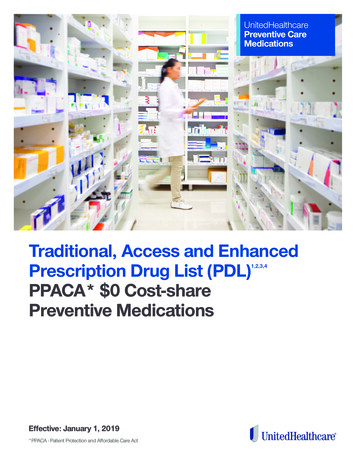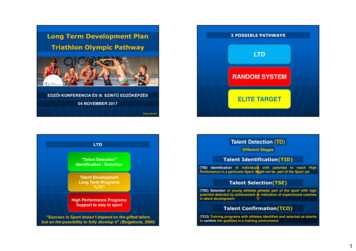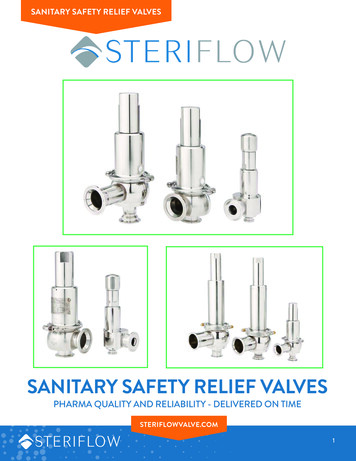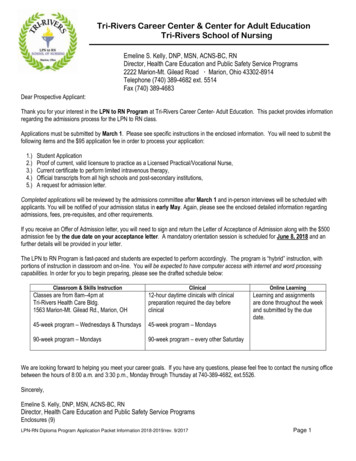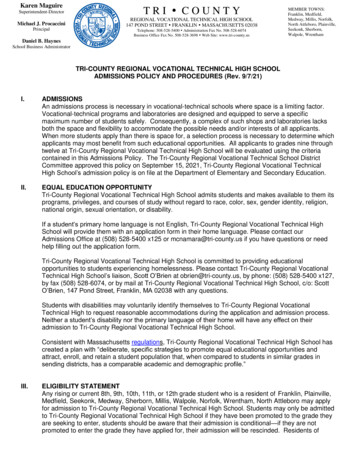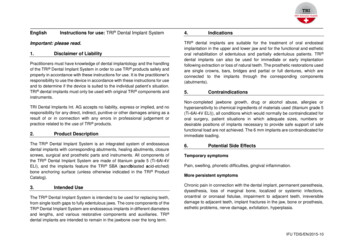
Transcription
EnglishInstructions for use: TRI Dental Implant SystemImportant: please read.1.Disclaimer of LiabilityPractitioners must have knowledge of dental implantology and the handlingof the TRI Dental Implant System in order to use TRI products safely andproperly in accordance with these instructions for use. It is the practitioner’sresponsibility to use the device in accordance with these instructions for useand to determine if the device is suited to the individual patient’s situation.TRI dental implants must only be used with original TRI components andinstruments.TRI Dental Implants Int. AG accepts no liability, express or implied, and noresponsibility for any direct, indirect, punitive or other damages arising as aresult of or in connection with any errors in professional judgement orpractice related to the use of TRI products.2.Product DescriptionThe TRI Dental Implant System is an integrated system of endosseousdental implants with corresponding abutments, healing abutments, closurescrews, surgical and prosthetic parts and instruments. All components ofthe TRI Dental Implant System are made of titanium grade 5 (Ti-6Al-4VELI), and the implants feature the TRI SBA (sandblasted acid-etched)bone anchoring surface (unless otherwise indicated in the TRI ProductCatalog).3.Intended UseThe TRI Dental Implant System is intended to be used for replacing teeth,from single tooth gaps to fully edentulous jaws. The core components of theTRI Dental Implant System are endosseous implants in different diametersand lengths, and various restorative components and auxiliaries. TRI dental implants are intended to remain in the jawbone over the long term.4.IndicationsTRI dental implants are suitable for the treatment of oral endostealimplantation in the upper and lower jaw and for the functional and estheticoral rehabilitation of edentulous and partially edentulous patients. TRI dental implants can also be used for immediate or early implantationfollowing extraction or loss of natural teeth. The prosthetic restorations usedare single crowns, bars, bridges and partial or full dentures, which areconnected to the implants through the corresponding eted jawbone growth, drug or alcohol abuse, allergies orhypersensitivity to chemical ingredients of materials used (titanium grade 5(Ti-6Al-4V ELI)), all conditions which would normally be contraindicated fororal surgery, patient situations in which adequate sizes, numbers ordesirable positions of implants necessary to provide safe support of safefunctional load are not achieved. The 6 mm implants are contraindicated forimmediate loading.6.Potential Side EffectsTemporary symptomsPain, swelling, phonetic difficulties, gingival inflammation.More persistent symptomsChronic pain in connection with the dental implant, permanent paresthesia,dysesthesia, loss of marginal bone, localized or systemic infections,oroantral or oronasal fistulae, impairment to adjacent teeth, irreversibledamage to adjacent teeth, implant fractures in the jaw, bone or prosthesis,esthetic problems, nerve damage, exfoliation, hyperplasia.IFU TDIS/EN/2015-10
7.Operation technique with TRI Dental Implants7.3.7.1.General Warning and CautionsBefore starting the drilling procedure, make sure that the depth markings ofthe TRI surgical instruments are understood correctly:Surgical ProcedureGeneral Warnings: Products must be secured against aspiration when handledintraorally. Aspiration of products may lead to infection orunplanned physical injury.Avoid proximity to the mandibular nerve channel during implant bedpreparation and implant insertion. Nerve damage may result inanesthesia, paresthesia and dysesthesia.Cautions: 7.2.Make sure that the internal configuration of the implant is correctlyaligned. For more details, please consult chapter 7.4Implant Insertion.MRI safety information: Please note that the product has not beenevaluated for safety and compatibility in the MR environment. Theproduct has not been tested for heating or migration in the MRenvironment.Figure 1: Depth markings of TRI surgical instrumentsUsed for TRI -Vent, TRI -Narrow and TRI -Octa(example 11.5mm implant).Figure 2: Depth markings of TRI surgical instruments used forTRI -Narrow (example 11.5 mmimplant)Preparation and Planning of the Surgical ProcedureThe planning of the surgical procedure requires profound knowledge indental implantology. Please use the TRI X-Ray template for implantplanning or any software system that is compatible with TRI DigitalSolutions.Caution: Allow for 1mm of pilot drill overlength when planning your implantposition.Caution: Wrong planning of the length for drilling can result in damage tothe alveolar nerve of the patient. Make sure to read your x-ray dimensionscorrectly.Strictly follow the drilling sequence and maximum amount of revolutionsper minute (RPM) described in Table 1 and Figure below:Table 1: Maximum RPMArt. No.LD-1.6RB-2.3SKTPD 2.3 STPD 2.3 LTND-3.3LTAP3.3TVSBD-3.7 STVSBD-3.7 LTVDBD-3.7 LDimension /DescriptionLindemann drillRound burØ 2.3 mmØ 2.3 mmØ 2.4/2.8 mmØ 3.3 mmØ 2.7/3.1 mmØ 2.7/3.1 mmØ 2.9/3.6 mmMax.RPM80080080080080015800800800Art. No.TAP3.7TVSBD-4.1 STVSBD-4.1 LTVDBD-4.1 LTAP4.1TVSBD-4.7 STVSBD-4.7 LTVDBD-4.7 LTAP4.7Dimension /DescriptionØ 3.75 mmØ 3.0/3.4 mmØ 3.0/3.4 mmØ 3.2/3.9 mmØ 4.1 mmØ 3.6/4.0 mmØ 3.6/4.0 mmØ 3.8/4.5 mmØ 4.7 mmMax.RPM156006006001560060060015IFU TDIS/EN/2015-10
Caution: Excessive drilling depth can lead to permanent damage to thealveolar nerve of the patient. Make sure that the depth markings are clearlyvisible during the entire surgical process, or use the TRI Drill Stop System.Align the flat side of the hex buccally, except when using TV50-17 orTV50-30 abutments.Caution: Never exceed an insertion torque of 40 Ncm. Over-tightening animplant may lead to to the implant damage, fracture or necrosis of the bonesite.7.5.Soft Tissue ManagementCaution: Surgical cover screws and healing components must not be reused.The healing components of the TRI Dental Implant System allow for onestage or two-stage surgery.For two-stage surgery, mount the surgical cover screw to the implant afterimplant placement. Tighten the surgical cover screw with a torque of15 Ncm.The TRI Dental Implant System contains various healing components forsoft tissue management. Use these components according to the patient’sanatomy and your selected treatment approach. For one-stage surgicalprocedures, mount the healing collar directly after implant placement.Tighten all healing collars with a torque of 15 Ncm.Caution: Never exceed an insertion torque of 15 Ncm. Over-tightening ahealing collar may lead to implant loss.Figure 3: Drill sequence for the TRI Dental Implant System7.4.Implant InsertionRemove the implant from the packaging without touching the non-sterilepackaging exterior, and never touch the implant directly.Insert the implant either with the TRI implant driver, the surgical hand pieceor the torque ratchet.7.6.Impression TakingThe TRI Dental Implant System allows for both an open-tray and closedtray impression technique. Please refer to the TRI Product Catalog for adetailed overview of available components.Caution: Make sure that the marking of the TRI -Octa ITC impressionabutments (TO10-35-ITC and TO10-50-ITC) are aligned buccally, both inpatient and model situations.IFU TDIS/EN/2015-10
7.7.Prosthetic ProceduresA torque of 30 Ncm must be used for all TRI abutments.A torque of 20 Ncm must be used for all prosthetic restorations screwed onto TRI abutments (e.g. 40 series).or partially edentulous jaw. Good primary stability and an appropriateocclusal load are essential.7.8.Patient RecordKeep the patient labels in your records to ensure proper traceability in caseof notifications or recalls by TRI Dental Implants Int. AG.The TRI Dental Implant System allows for the following prosthetic options:8.Table 2: Prosthetic optionsType of restorationTemporary restorationTRI product series10-seriesFinal cement-retainedrestoration with titaniumabutments.10-series straightabutments20-series angledabutmentsScrew-retainedrestoration with gold orplatinum abutment.Screw-retained multiunit restoration.Removable restorationwith LocatorTMRemovable restorationwith ball abutmentsCADCAM abutmentswith titanium base.30-series goldabutments35-series platinumNEM abutments40-series straight andangled (All-on-TRI )Cautions and notesCaution: Temporary crown shouldbe out of occlusion in order toprotect the implant during thehealing phase.Caution: Use correct torque of30Ncm in order to prevent screwloosening or inadequate abutmentpositioning.Compatibility InformationThe TRI Dental Implant System comprises the implant lines TRI -Narrow,TRI -Vent and TRI -Octa. Each line has its own components andabutments. For TRI -Vent implants, only use components and abutmentswith Article Number TN-XXX (colour code blue), for TRI -Vent TV-XXX(colour code green) and for TRI -Octa TO-XXX (colour code pink).Caution: Try to avoid excesscement when placing the abutment.-LocatorTMCaution: Place the flat side of theimplant mesially for 17 and 30 angled abutments (unlike all otherabutments).Caution: Use 20 Ncm forrestorations on top of 40 seriesabutments.-60-series-9.70-seriesNote: Request TRI files atdigital@tri-implants.com forcompatibility with CADCAMsystems.TRI dental implants are provided in sterile condition and for single useonly. They must not be cleaned or sterilized.Caution: The healing time required for osseointegration (and full loading ofthe implant) is very individual and treatment-dependent. It is the soleresponsibility of the surgeon to decide when the implant can be loaded.TRI dental implants are suitable, within the scope of application, forimmediate and early restoration in single-tooth gaps and in an edentulousFigure 4: Compatibility informationDisinfection, Cleaning and SterilizationAll surgical instruments must be cleaned, disinfected and sterilized prior touse.IFU TDIS/EN/2015-10
CleaningTable 3: Different sterilization methods1. Place the disassembled instruments in the cleaning bath for thespecified time (make sure that the instruments are completelycovered). If necessary, brush carefully with a soft brush. Make surethat the instruments do not come into contact with one another.Rinse out all instrument cavities three times (3x) at the beginningor end of cleaning period, using a disposable syringe (minimumvolume 20 ml).2. Remove the instruments from the cleaning bath and rinse themthoroughly with water at least three times (3x).Disinfection3. Place the disassembled, cleaned instruments in the disinfectionbath for the specified time. Ensure that the instruments aresufficiently covered by the disinfection solution and that theinstruments do not come into contact with one another. Rinse outall instrument cavities three times (3x) at the beginning or end ofdisinfection period, using a disposable syringe (minimum volume20 ml).4. Remove the instruments from the disinfection bath and rinse themthoroughly with water at least five times (5x).5. Dry the instruments internally and externally with filteredcompressed air.Sterilization6. Sterilize the instruments according to the following specifications:Sterilization methodFractionated vacuummethodat least 20 min. at121 C (250 F) ORat least 3 min. at132 C (270 F) up to134 C (273 F)10.Gravitation methodCommentsat least 5 min. at132 C (270 F) up to134 C (273 F)Maximum sterilization temperature134 C (273 F)Make sure to use sufficient time fordryingValidityUpon publication of these instructions for use, all previous versions aresuperseded. TRI Dental Implants Int. AG, 2015. All right reserved. TRI and/or othertrademarks and logos from TRI mentioned herein are the trademarks orregistered trademarks of TRI Dental Implants Int. AG, Switzerland.11.AvailabilityCertain items of the TRI Dental Implant System are not available in allcountries.12.Explanation of abbreviations and symbolConsult Instructions for UseManufacturerSee Instructions for UseDo not re-useUse-by dateBatch codeCatalog numberSterilized using radiationIFU TDIS/EN/2015-10
TRI Dental Implants products with the CE mark fulfilthe requirements of the Medical Devices Directive93/42 EEC1023 identifies the notified body of manufacturersCaution: U.S. federal law restricts this device to sale byor on behalf of a dental professionalManufacturer:TRI Dental Implants Int. AG,Lindenstrasse 14, CH-6340 Baar,SwitzerlandFree Infoline: 00800 3313 3313,www.tri-implants.comIFU TDIS/EN/2015-10
Insert the implant either with the TRI implant driver, the surgical hand piece or the torque ratchet. Align the flat side of the hex buccally, except when using TV50-17 or TV50-30 abutments. Caution: Never exceed an insertion torque of 40 Ncm. Over-tightening an implant may lead to to the implant damage, fracture or necrosis of the bone

